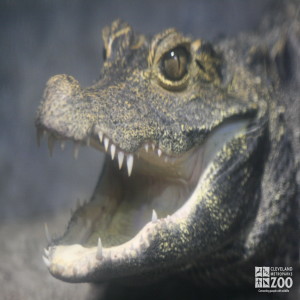Dwarf Crocodile
[Osteolaemus tetraspis]

The Dwarf Crocodile is a heavily armored, small crocodile which reaches a maximum length of 6 feet and weighs between 40-71 lbs. This crocodile has coloring that is dark on top and yellowish underneath. The dwarf crocodile has a blunt, short snout, and the upper eyelid is almost completely ossified. This is a timid, slow moving, nocturnal animal which, as an adult is usually solitary. Although it usually feeds in water it apparently spends a lot of time on land, and it inhabits holes excavated in the banks of streams.
Location: The Lower RainForest
Share:
Range
The Dwarf Crocodile has a range of West and west central Africa including Sierra Leone, Guinea, Ghana, Togo, Nigeria, Cameroons, Gabon, Liberia and Angola
Habitat
Dwarf Crocodiles inhabit swamps and swamp forests; slow moving, calm bodies of water.
Conservation Status
VulnerablePrimary Threats
Human-Wildlife Conflict. Deforestation, and Habitat Loss.Gestation
The incubation of dwarf crocodile eggs takes 85-105 days.
Litter
Clutch Size: 10-20 eggs
Behavior
The Dwarf Crocodile is a timid, slow moving, nocturnal animal which, as an adult is usually solitary. Although it usually feeds in water it apparently spends a lot of time on land, and it inhabits holes excavated in the banks of streams. In forested areas they are known to make extensive nocturnal forays on land, especially after rains, but the purpose of these trips is not fully understood.
Reproduction
Female dwarf crocodiles are mound-nesters, constructing a nest that is approximately 5 feet in diameter. May-June during the wet season. The eggs are laid early in the wet season. Newly laid eggs are semitransparent and a yellowish color. One day after laying they begin to exhibit a narrow white band which expands with time to give the whole egg a milky white appearance. Hatching may take up to a week after the first crack appears. Females are good mothers, guarding the eggs in carefully constructed nests. Hatchlings are 8-12" long and weigh about 1 3/4 oz. After hatching the young remain with the mother for several weeks.
Wild Diet
Fish, frogs and crustaceans
